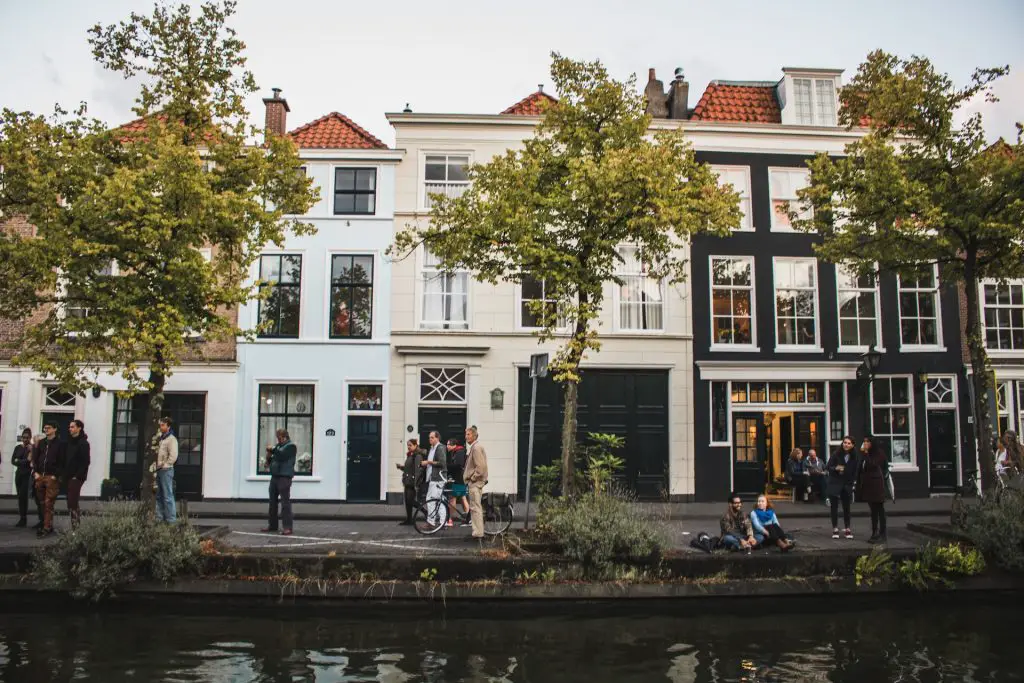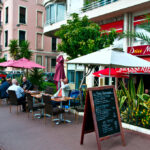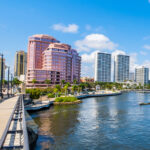When people think of the Netherlands, often the windmills of Zaanse Schans, the canals of Amsterdam, or the tulip fields of Keukenhof come to mind. However, the Netherlands boasts another gem, the regal and serene city of The Hague (Den Haag in Dutch). As the third-largest city in the country and the seat of the Dutch government, The Hague has a unique blend of historical significance, modernity, and coastal beauty.
Historical and Cultural Significance
Unlike many other major cities, The Hague is not a city built around a cathedral or a major trade center, but rather around the Medieval Binnenhof. The Binnenhof, which is the world’s oldest House of Parliament still in use, offers a stunning glimpse into Dutch history. Over the centuries, The Hague evolved into a city of diplomats and royals, with palaces, embassies, and mansions lining its streets.
The city is also home to the Peace Palace, an icon of international diplomacy. Housing the International Court of Justice and the Permanent Court of Arbitration, it stands as a testament to The Hague’s role in global peacekeeping efforts. Moreover, its gorgeous architecture and surrounding gardens make it a must-visit.
Museums and Art
Art lovers will be mesmerized by The Mauritshuis, a 17th-century mansion-turned-museum, showcasing masterpieces from the Dutch Golden Age, including Vermeer’s “Girl with a Pearl Earring” and Rembrandt’s self-portraits. Another notable art institution is the Gemeentemuseum, which houses the world’s largest collection of Piet Mondrian artworks.
For a more modern twist, the M.C. Escher Museum, located in the former royal palace, is an interactive experience dedicated to the famous artist’s mind-bending, impossible constructions.
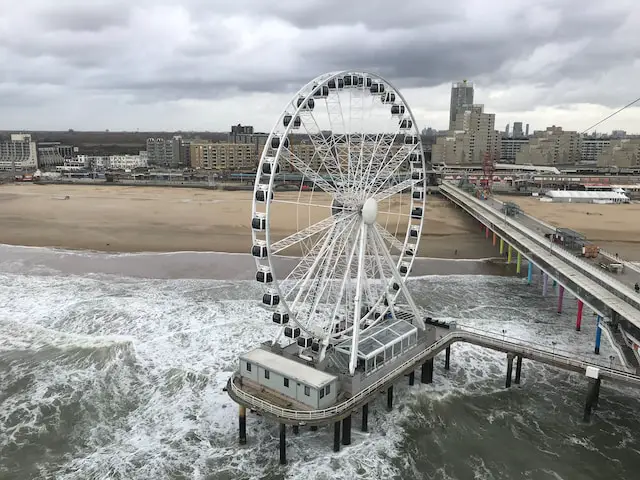
Beach and Parks
Beyond the bustling city center lies Scheveningen, The Hague’s famous beach resort area. With its long sandy beaches, it’s a perfect spot for sunbathing, kite surfing, or enjoying a meal at one of the many beachside cafes. The Pier at Scheveningen is a major attraction, offering a bungee jumping tower, a Ferris wheel, and stunning views of the North Sea.
The Hague’s green spaces are equally captivating. The Japanese Garden in Clingendael Park is a tranquil oasis that opens its gates for a few weeks each year, allowing visitors to experience its delicate beauty. Meanwhile, Westbroekpark is a sprawling space known for its beautiful rose gardens.
Shopping and Dining
The Hague’s shopping district offers a mix of high-end boutiques, international chains, and local shops. The “Passage”, a beautiful covered shopping street, dates back to 1885 and is a joy to explore, with its architectural grandeur and specialty stores.
When it comes to dining, The Hague offers a rich culinary scene that reflects its international character. From Indonesian rijsttafel (a colonial-era feast of small dishes) due to the Dutch colonial history in Indonesia, to fresh seafood dishes in Scheveningen, there’s something for every palate.
Festivals and Events
Throughout the year, The Hague becomes a stage for various events and festivals. King’s Day, celebrated on April 27th, sees the entire city adorned in orange, with parties, flea markets, and parades. The International Fireworks Festival in Scheveningen is another spectacle, drawing crowds to its explosive displays.
Practical Information
Getting Around: The Hague boasts an efficient public transport system, including trams and buses. The OV-chipkaart, a rechargeable card, can be used for all public transport modes, making commuting a breeze. For short distances, renting a bicycle is a truly Dutch way to explore the city.
Language: While Dutch is the official language, English is widely spoken, especially in tourist areas, restaurants, and museums.
Currency: The Netherlands uses the Euro (€). Credit cards are widely accepted, and ATMs are easily accessible.
Weather: The Hague enjoys a maritime climate, with mild summers (17-25°C) and cool winters (2-6°C). It’s always wise to carry a raincoat or umbrella.
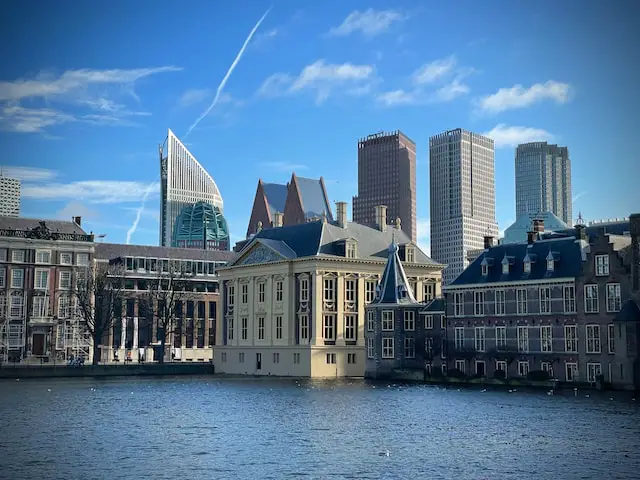
The Hague offers a harmonious blend of the old and the new, with its historical landmarks, modern institutions, bustling shopping streets, and serene beaches. Whether you’re a history buff, an art lover, a beach enthusiast, or a foodie, The Hague promises a delightful experience that’s worth cherishing. So, pack your bags and immerse yourself in the regal charm of this Dutch city!
Accommodation in The Hague
The range of accommodation options in The Hague caters to a diverse audience, from luxury seekers to budget travelers.
Luxury: If you want to experience the city’s royal charm to its fullest, consider staying at Hotel Des Indes, a five-star establishment that once served as a palace. Located near the city center, this luxurious hotel has hosted many dignitaries and celebrities over the years.
Mid-Range: The Hague offers a plethora of boutique hotels that provide a unique blend of comfort and character without breaking the bank. The Paleis Hotel, with its elegant rooms, is a stone’s throw away from the Binnenhof and other major attractions.
Budget: For those traveling on a shoestring, The Hague hasn’t forgotten you. Hostels like the Kingkool City Hostel provide clean, vibrant, and affordable lodging. Moreover, many of these establishments are centrally located, making sightseeing a breeze.
Local Cuisine and Must-Try Dishes
Dutch cuisine, influenced by its maritime climate and colonial history, offers a plethora of hearty and delicious dishes.
Haring: Raw herring fish served with onions. Best enjoyed fresh from a fish stall.
Stroopwafel: A delightful treat made of two thin waffles sandwiching a layer of sweet syrup.
Bitterballen: Savory orbs of crispy fried goodness, filled with a mixture of beef or veal ragout. Best paired with a pint of local beer.
Poffertjes: Miniature, fluffy pancakes traditionally served with a dusting of powdered sugar and a dollop of butter.
Erwtensoep: A thick pea soup, packed with vegetables and pork, usually enjoyed during the colder months.
Local Etiquette and Tips
Dutch Directness: The Dutch are known for their straightforwardness, which can sometimes be mistaken for bluntness. It’s just their way of clear communication and is not meant to be rude.
Greetings: A handshake is the common form of greeting. Close friends may greet each other with three cheek kisses, starting from the left.
Tipping: Service charge is included in your bill in most establishments. However, it’s customary to leave small change, especially if you’ve received good service.
Day Trips from The Hague
Delft: Just a short train ride away, Delft is known for its blue pottery, historic buildings, and its association with the famous painter, Johannes Vermeer. It’s a quaint town that offers a peaceful escape from the city.
Rotterdam: Known for its modern architecture and bustling port, Rotterdam offers a stark contrast to The Hague’s historic charm. The Cube Houses and the Markthal are must-see attractions.
Keukenhof: Visit during the spring to witness the Netherlands in full bloom. Keukenhof is one of the world’s largest flower gardens, especially famous for its stunning tulip displays.
The Hague, with its multifaceted attractions, offers more than just a glimpse into the Dutch political arena. Its historical landmarks, stunning beaches, cultural festivals, and delicious cuisine make it a must-visit destination in the Netherlands. So, on your next European escapade, make sure to stroll through its charming streets, sip on some Dutch coffee, and let The Hague enchant you.
